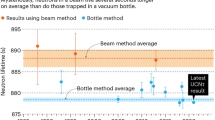Summary
In order to derive in a convincing manner the formula of Goldberger and Treiman for the rate of charged pion decay, we consider the possibility that the divergence of the axial vector current in β-decay may be proportional to the pion field. Three models of the pion-nucleon interaction (and the weak current) are presented that have the required property. The first, using gradient coupling, has the advantage that it is easily generalized to strange particles, but the disadvantages of being unrenormalizable and of bringing in the vector and axial vector currents in an unsymmetrical way. The second model, using a strong interaction proposed bySchwinger and a weak current proposed byPolkinghorne, is renormalizable and symmetrical betweenV andA, but it involves postulating a new particle and is hard to extend to strange particles. The third model resembles the second one except that it is not necessary to introduce a new particle. (Renormalizability in the usual sense is then lost, however). Further research along these lines is suggested, including consideration of the possibility that the pion decay rate may be plausibly obtained under less stringent conditions.
Riassunto
Allo scopo di dedurre in maniera convincente la formula di Goldberger e Treiman per il tasso di decadimento dei pioni carichi, prendiamo in considerazione la possibilità che la divergenza della corrente vettoriale assiale nel decadimento β sia proporzionale al campo del pione. Si presentano tre modelli della interazione pionenucleone (e della corrente debole) che hanno la proprietà richiesta. Il primo, che si serve dell’accoppiamento di gradiente, ha il vantaggio di poter essere facilmente generalizzato alle particelle strane, ma gli svantaggi di non essere rinormalizzabile e di introdurre le correnti vettoriale e vettoriale assiale in modo asimmetrico. Il secondo modello, che usa un’interazione forte proposta daSchwinger ed una corrente debole proposta daPolkinhorne, è rinormalizzabile e simmetrico fraV edA, ma comporta la postulazione di una nuova particella ed è difficilmente estensibile alle particelle strane. Il terzo modello è simile al secondo salvo che non è necessario introdurre una nuovo particella. (Si perde, tuttavia, la rinormalizzazione nel senso usuale.) Si suggerisce una ulteriore ricerca su queste linee, compresa la considerazione della possibilità che il tasso di decadimento del pione possa ottenersi in modo plausibile con condizioni meno restrittive.
Similar content being viewed by others
References
S. M. Berman:Phys. Rev.,112, 267 (1958).
Private communication fromV. L. Telegdi on the work of the Chicago group.
R. P. Feynman andM. Gell-Mann:Phys. Rev.,109, 193 (1958).
E. C. G. Sudarshan andR. E. Marshak:Phys. Rev.,109, 1860 (1958).
S. S. Gershtein andJ. B. Zeldovich:Žurn. Ėksp. Teor. Fiz.,29, 698 (1955) (translation:Sov. Phys. Journ. Exp. Theor. Phys.,2, 576 (1957)).
D. A. Bromley, E. Almquist, H. E. Gove, A. E. Litherland, E. B. Paul andA. J. Ferguson:Phys. Rev.,105, 957 (1957).
M. Gell-Mann:Phys. Rev.,111, 362 (1958).
M. T. Burgy, V. E. Krohn, T. B. Novey, G. R. Ringo andV. L. Telegdi:Phys. Rev.,110, 1214 (1958). See alsoC. S. Wu:Rev. Mod. Phys.,31, 783 (1959).
J. C. Taylor:Phys. Rev.,110, 1216 (1958);M. L. Goldberger andS. B. Treiman:Phys. Rev.,110, 1478 (1958).
R. J. Blin-Stoyle:Nuovo Cimento,10, 132 (1958);S. Okubo:Nuovo Cimento,13, 292 (1959).
ByR. P. Feynman, with some assistance from one of us (M. G.-M.).
R. E. Norton andW. K. R. Watson:Phys. Rev.,110, 996 (1958).
J. C. Taylor: quoted in ref. (17). See alsoR. F. Streater andJ. C. Taylor:Nucl. Phys.,7, 276 (1958).
M. L. Goldberger andS. B. Treiman:Phys. Rev.,110, 1178 (1958). A recent criticism of their paper has been given byR. F. Sawyer:Phys. Rev.,116, 231 (1959); like us,Sawyer seeks a better derivation of their result.
As listed byK. M. Crowe:Nuovo Cimento,5, 541 (1957).
See forthcoming article byBernstein, Fubini, Gell-Mann andThirring.
Our point of view in this section has much in common with that ofS. Glashow:Nucl. Phys.,10, 107 (1959), as well as that ofS. Bludman:Nuovo Cimento,9, 433 (1958). See, also, the earlier work ofJ. Schwinger: ref. (16).
J. Schwinger:Ann. Phys.,2, 407 (1957).
J. C. Polkinghorne:Nuovo Cimento,8, 179, 781 (1958).
J. Bernstein, M. Gell-Mann andL. Michel:Nuovo Cimento,16, 560 (1960).
M. Gell-Mann:Phys. Rev.,106, 1296 (1957) andJ. Schwinger: ref. (16).
F. Gürsey:Nuovo Cimento,16, 230 (1960).
A. Pais:Proc. Nat. Acad. Sci.,40, 835 (1954).
Author information
Authors and Affiliations
Additional information
Supported in part by the Alfred P. Sloan Foundation and by the United States Air Force through the European Office, Air Research and Development Command.
National Science Foundation Senior Postdoctoral Fellow.
Rights and permissions
About this article
Cite this article
Gell-Mann, M., Lévy, M. The axial vector current in beta decay. Nuovo Cim 16, 705–726 (1960). https://doi.org/10.1007/BF02859738
Received:
Published:
Issue Date:
DOI: https://doi.org/10.1007/BF02859738



